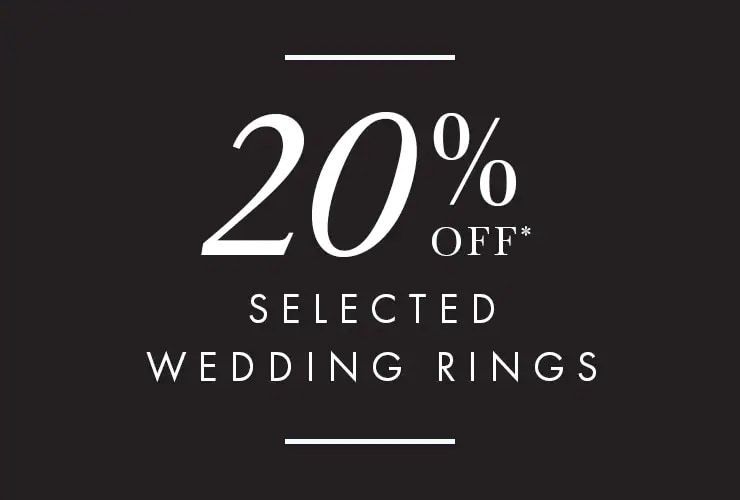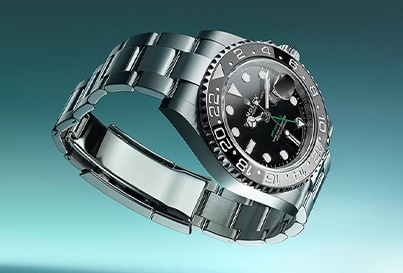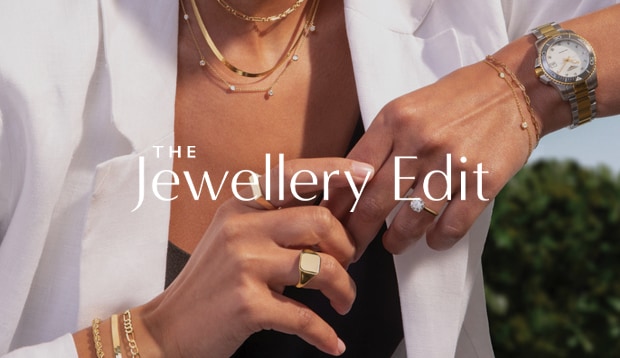-
Sale
Sale JewellerySale WatchesBy BrandBy Price
-
Diamonds
By Category
-
Engagement
By Category
-
Weddings
Featured
- Jewellery
By CategoryBy Metal TypeBy GemstoneBy BrandBy Edit- Watches
By CategoryBy CollectionBy Luxury BrandBy Designer Brand- Rolex
- Rolex Certified Pre-Owned
- Brands
Brands A-Z- Gifts
By PriceBy Popular Brand- Pre-Owned
- Sell Your Watch
Sell your watchWe will expertly assess your watch and offer you
a competitive and accurate valuation for the
watch you wish to sell to us.Free Instant Valuation
Drop off at any Showroom
Unrivalled Knowledge & Expertise- Editorial
- Jewellery
- Shop by Category
- SALE
- Diamonds
- Engagement Rings
- Weddings
-
Jewellery
- Back
- Jewellery Offers
- Shop All Jewellery
- Jewellery Home
- By Category
- By Metal Type
- By Gemstone
-
By Brand
- 886 by The Royal Mint
- Bijoux Birks
- BOSS
- Calvin Klein
- Chopard
- Emporio Armani
- Fabergé
- FOPE
- FRED
- Georg Jensen
- Goldsmiths
- Gucci
- Jenny Packham
- Kiki McDonough
- Lauren By Ralph Lauren
- Mappin & Webb
- Marco Bicego
- MARIA TASH
- Messika
- Michael Kors
- Olivia Burton
- Pasquale Bruni
- Pomellato
- Roberto Coin
- Skagen
- Susan Caplan
- SUZANNE KALAN
- SWAROVSKI
- Ted Baker
- THOMAS SABO
- Tommy Hilfiger
- By Edit
-
Watches
- Back
- Watch Offers
- Shop All Watches
- Watches Home
- By Category
- By Collection
-
By Luxury Brand
- Rolex
- BALL
- Bamford
- Baume & Mercier
- Bell & Ross
- Breitling
- Bremont
- Cartier
- CHANEL
- Chopard
- DOXA
- Frederique Constant
- Girard-Perregaux
- Glashütte Original
- Grand Seiko
- Gucci
- Hublot
- ID Genève
- IWC Schaffhausen
- Jaeger-LeCoultre
- Junghans
- Longines
- MeisterSinger
- Montblanc
- Nivada Grenchen
- NOMOS Glashütte
- NORQAIN
- OMEGA
- Oris
- Panerai
- Piaget
- Rado
- RAYMOND WEIL
- TAG Heuer
- TUDOR
- Ulysse Nardin
- ZENITH
- By Designer Brand
- Rolex
- Rolex Certified Pre-Owned
-
Brands
- Back
- View All Brands
-
A-Z
- Rolex
- 886 by The Royal Mint
- Accurist
- BALL
- Bamford
- Baume & Mercier
- Bell & Ross
- Bijoux Birks
- BOSS
- Breitling
- Bremont
- BVLGARI
- Calvin Klein
- Cartier
- Certina
- CHANEL
- Chopard
- Citizen
- DOXA
- Duckworth Prestex
- Elliot Brown
- Emporio Armani
- Encelade 1789
- Fabergé
- Fendi
- FOPE
- FRED
- Frederique Constant
- Garmin
- Georg Jensen
- Girard-Perregaux
- Glashütte Original
- Goldsmiths
- Grand Seiko
- Gucci
- Hamilton
- Hublot
- ID Genève
- IKEPOD
- IWC Schaffhausen
- Jacob & Co
- Jaeger-LeCoultre
- Jenny Packham
- Junghans
- Kiki McDonough
- Lauren By Ralph Lauren
- Longines
- Mappin & Webb
- Marco Bicego
- MARIA TASH
- Maurice Lacroix
- MeisterSinger
- Michael Kors
- Messika
- Mondaine
- Montblanc
- Nivada Grenchen
- NOMOS Glashütte
- NORQAIN
- Olivia Burton
- OMEGA
- Oris
- Panerai
- Pasquale Bruni
- Piaget
- Pomellato
- QLOCKTWO
- Rado
- RAYMOND WEIL
- Roberto Coin
- Rolex
- Seiko
- Sekonda
- Skagen
- Susan Caplan
- SUZANNE KALAN
- SWAROVSKI
- Swiss Capsule
- TAG Heuer
- Ted Baker
- THOMAS SABO
- Tissot
- Tommy Hilfiger
- TUDOR
- Ulysse Nardin
- Vivienne Westwood
- William Wood Watches
- WOLF
- ZENITH
- Gifts
-
Pre-Owned
- Back
- Shop All Pre-Owned
- Pre-Owned Home
- By Category
-
By Brand
- Pre-Owned Rolex
- Pre-Owned Patek Philippe
- Pre-Owned TAG Heuer
- Pre-Owned Cartier
- Pre-Owned Jaeger-LeCoultre
- Pre-Owned Breitling
- Pre-Owned OMEGA
- Pre-Owned Longines
- Pre-Owned Tudor
- Pre-Owned IWC
- Pre-Owned Panerai
- Pre-Owned Blancpain
- Pre-Owned Breguet
- Pre-Owned Chopard
- Pre-Owned Rado
- Pre-Owned Vacheron Constantin
- Pre-Owned Zenith
- Sell Your Watch
- Editorial
- My Account
- Wishlist
- Store Finder
- Book an Appointment
- Help & Support
Goldsmiths Guide to Getting Engaged
Ring Metals
- Home
- Engagement Guides
- Ring Metals
While talk around wedding bands usually centers around the type and size of the diamond, the metal or combination of metals which you choose for your wedding and engagement rings also speak volumes: emotionally, symbolically and aesthetically. There are a number of metals, though the following gives an outline of the core metals in our Goldsmiths range.
Platinum
A white metal, platinum is one of the most popular for both wedding bands and engagement rings. With a more "grey" finish than white gold, diamonds can seem even more sparkling in comparison, and the metal will acquire a duller patina over time, which is seen as desirable. Unlike white gold, platinum does not require re-plating every few years.
Goldsmiths have a range of platinum wedding rings, from slim, shaped styles set with brilliant cut diamonds to heavier weight simple bands for men and women. In addition to platinum's undeniable opulence, clients enjoy the higher density and heavier weight of our precious platinum rings, as well as their nickel-free and hypoallergenic qualities.
Because platinum is the perfect showcase metal for glittering diamonds, Goldsmiths' diamond solitaire engagement rings are increasingly popular: there is no mistaking that platinum is the luxe choice for your rings.
White Gold
White gold engagement rings are available from Goldsmiths in 9 carat and 18 carat purity levels. While all white gold is an alloy - composed of yellow gold mixed with nickel, manganese, or palladium- 18 carat white gold offers around 75% pure gold, alongside a really bright, lustrous finish, which is part of the reason why it's so desirable.
There are some truly spectacular white gold engagement rings on offer, featuring solitaires, diamond clusters, and glamorous princess cut diamonds. White gold is in many ways the ideal metal for your wedding ring, as it offers the luxury and prestige of real gold but with a cool, elegant, and silvery tone.
With pieces crafted by top-name designers such as Jenny Packham, as well as our own rings designed and manufactured in-house, the choice available is truly comprehensive when it comes to both wedding and engagement rings in shimmering white gold.

Yellow Gold
Warm, sumptuous yellow gold is the traditional metal of choice for both wedding rings. Prized above other precious metals, gold's emotional and financial worth is evident in the language: we talk about the "gold standard", about "golden rules" and the "golden age".
Here at Goldsmiths, we offer gorgeous yellow gold wedding bands in 9 or 18 carats, set with diamonds, rubies, emeralds, and sapphires, as well as less adorned styles in a contemporary finish.
For a really classic, romantic look, it's hard to find a metal to surpass yellow gold. The honey-coloured tones of this precious metal set clear diamonds off to perfection, while slim golden bands are often the first thing that comes to mind when we picture marriage.
Rose Gold
Popular among the Tsars in Russia, rose gold has become an increasingly attractive choice for modern couples seeking to tie the knot. The blush-colour of the metal symbolises love and affection, and it's perfectly acceptable to team rose gold pieces with items of jewellery in more common white or yellow gold.
Rose gold is often used as an accent metal, although the radiance of its colour means that it's also an excellent choice for an entire ring as it shows off diamonds to perfection: something recognised by Goldsmiths' own master craftspeople, as well as those employed by Ponte Vecchio, whose engagement rings we also stock.
Thanks to rose gold's high purity levels and low reactivity, it doesn't tarnish, and is a relatively low-maintenance precious metal. It gains its pink tones from the addition of copper, rather than nickel, making it less likely to cause skin irritation than white gold.
Consideration for Metals
Ultimately, the choice of metal or metals used in your wedding and engagement rings is very personal. Your lifestyle as well as your aesthetic preferences - and the jewellery you already own and wear will need to be considered before you reach a final decision.
As a rule of thumb, it's generally best to keep to just one type of precious metal per hand. While white, yellow, and rose golds can easily be worn together, it's less advisable to team gold of any shade with platinum, as the denser platinum can wear the gold away.
If you are finding it hard to narrow down your choice, Goldsmiths also stock a range of wedding rings which include various metal combinations, including appealing intertwining yellow, white, and rose wedding rings, symbolising compatibility, fidelity, and romance.
© 2024 Goldsmiths
Goldsmiths is a trading name of Watches of Switzerland Company Limited. Registered Office: Aurum House, 2 Elland Road, Braunstone, Leicester, LE3 1TT, Registered in England and Wales, Company number 00146087. Registered VAT Number 834 8634 04. Watches of Switzerland Company Limited acts as a broker and not a lender and offers finance from Secured Trust Bank PLC trading as V12 Retail Finance and PayPal UK Ltd, Whittaker House, Whittaker Avenue, Richmond-Upon-Thames, Surrey, United Kingdom, TW9 1EH trading as PayPal Credit. Watches of Switzerland Company Limited is authorised and regulated by the Finance Conduct Authority. Our registration number is 308710. Credit provided is subject to age and status, minimum spend applies. Terms and Conditions apply. UK residents only. We may receive a commission if your application is successful, and the amount may vary depending on the product chosen and the amount of credit taken out. Not all products are regulated by the Financial Conduct Authority and FOS protection will not be extended to unregulated agreements. Please note the Consumer Credit Act states that should your purchase / loan amount cost more than £30,000 you will not be covered under Section 75 of the Consumer Credit Act.
*Next day delivery available on most items. See product pages for more information.








